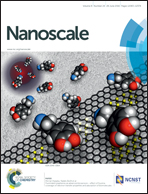Asymmetric plasmonic induced ionic noise in metallic nanopores†
Abstract
We present distinct asymmetric plasmon-induced noise properties of ionic transport observed through gold coated nanopores. We thoroughly investigated the effects of bias voltage and laser illumination. We show that the potential drop across top-coated silicon nanocavity pores can give rise to a large noise asymmetry (∼2–3 orders of magnitude). Varying the bias voltage has an appreciable effect on the noise density spectra, typically in the Lorentzian components. The laser power is found to strongly affect the ionic noise level as well as the voltage threshold for light-induced noise generation. The asymmetric noise phenomenon is attributed to plasmon-induced interfacial reactions which promote light-induced charge fluctuation in the ion flow and allow voltage modulation of photo-induced carriers surmounting over such Schottky junctions. We further compare the ionic noise performances of gold nanocavities containing different material stacks, among which thermal oxide passivation of the silicon successfully mitigates the light-induced noise and is also fully CMOS-compatible. The understanding of the described noise characteristics will help to foster multiple applications using related structures including plasmonic-based sensing or plasmon-induced catalysis such as water splitting or solar energy conversion devices.



 Please wait while we load your content...
Please wait while we load your content...